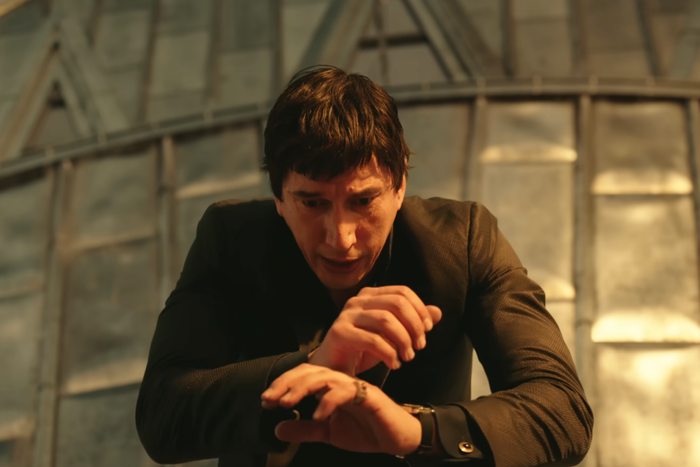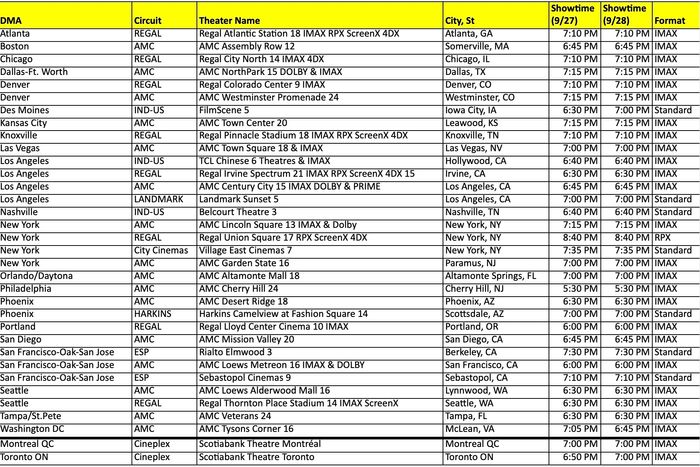
Francis Ford Coppola’s Megalopolis, a movie the 85-year-old director began making decades ago, is fixated on the future. The film’s characters, all members of a fableized city-state elite in the moments leading up to the fall of the American empire, wax philosophical about it constantly: about who will hold power, what civilization will look like, matters of inheritance, succession, growth, and decay. But the most effective expression of the film’s futurism isn’t in the dialogue so much as in Coppola’s filmmaking and technical experimentalism. Throughout the film’s 138 minutes, he plays with triptych split screens and surreal, trippy CGI, and in a postmodernist time warp, blends these overtly digital techniques with more blatant, old-timey effects like iris shots, used to denote focus or end scenes.
The one effect that seems to have captured film nerds’ imaginations more than any other is a “live” fourth-wall break, in which Adam Driver’s character, Cesar Catilina, responds to a question posed by an actual performer in the movie theater where Megalopolis is screening. When word got out about this reality-busting moment from Megalopolis’s world premiere at Cannes, it was unclear whether or not this element would carry over to public screenings beyond the festival. Just as the film started rolling out nationwide, Lionsgate announced a list of select screenings and theaters across the country where the live moment will be incorporated during opening weekend. Beyond those special showings, regular screenings will take place entirely in two pre-recorded dimensions.
I attended one such special screening of Megalopolis in Imax on Monday, September 23, which opened with a conversation among Francis Ford Coppola, Robert De Niro, Spike Lee, and NYFF’s Dennis Lim and was simulcast to Imax theaters across the continent. Coppola addressed mixed reactions to his opus, suggesting that it’s maybe just too forward-thinking, with too much going on, for viewers to appreciate it after one showing. “There are some movies that, especially if there’s more to them, you don’t totally get it all the first time, that have longevity just by virtue of getting more out of it every time you see it. I’m hoping for that. Because people love it, and people hate it. It’s the best reaction you could get for a movie,” he said. (“My films are a little prescient,” he later added.)
In love or hate, my audience was totally locked in for the live element. A little over halfway through the movie (I think … time really moves differently at a 9 p.m. showing of Megalopolis), following an environmental catastrophe that harms the mythical city of New Rome, the film fades to black. After a beat, the house lights came up in the 512-seat auditorium, and standing near the front of the screen was a man facing away from the audience and toward the projection, speaking into a microphone stand. The screen faded in on Cesar Catilina, sitting at a desk, staring down in the direction of this live performer or “reporter.” At our screening, the reporter had some flourishes: He wore a fedora, and he mimed taking notes in a reporter’s notebook. Perhaps each of these performers is allowed to take creative liberties, because I didn’t see similar prop work in videos on social media from other towns.
Accounts coming out of Cannes claimed that the “reporter” asks Driver’s character a question, but subsequent screenings for press and public (including mine) have revealed that the reporter’s question is in fact an audio recording already baked into the film. The mic really sells the illusion that the question is live, though. Many of my colleagues who have seen the film thought that the recorded voice sounded like it belonged to Jason Schwartzman. In the film, he has a minor role as “Jason Zanderz,” a be-tunic’d deliverer of mild comic relief in Mayor Cicero’s (Giancarlo Esposito) entourage. Vulture reached out to Megalopolis’s press team to get to the bottom of this, and to all of our surprise, they confirmed that the voice does not belong to Schwartzman, which adds an extra layer of mystery to the moment.
As for the content of the scene itself, the “reporter” asks (via recording), “You said that as we jump into the future, there is nothing to be afraid of. But what if when we do jump into the future, there is something to be afraid of?” Catilina pauses a moment, and answers with a vague, Randian pontification. In my screening, the house lights then faded down, the live performer picked up his stand and walked into the wings, and the screen faded to black before the next scene began and the movie carried on. It was an electrifying moment, a novelty, and ultimately a little under a minute long, all-in. The scene itself is inconsequential enough that I could imagine it being edited out entirely in future cuts of the film, or — considering the reporter’s voice isn’t live — played out without the live-performance element. Would it feel a little off? Yeah. But so does so much of Megalopolis. It’s more of a feature than a bug, and I salute the audacity. They don’t build statues of critics, only statues of Jon Voight in a toga on the eve of his wedding to Wow Platinum.
Will you get a chance to see the fourth-wall-break scene in its intended live-participation format? Yes, if you act fast. At select Imax and PLF theaters in select cities during the film’s opening weekend, audiences can buy tickets to the Ultimate Experience version of Megalopolis, which will include what the film’s official materials refer to as the “Live Participant.” The list of Ultimate Experience screenings covers 34 theaters in 23 cities on September 27 and September 28.
If the strangest minute in 2024 cinema excites you, you should get a ticket to see the Ultimate Experience now. If you can’t make it to one of these, well, you could always go rogue at your local screening of Megalopolis and mime the live performance yourself. Be the futuristic utopia you want to see in the world.



